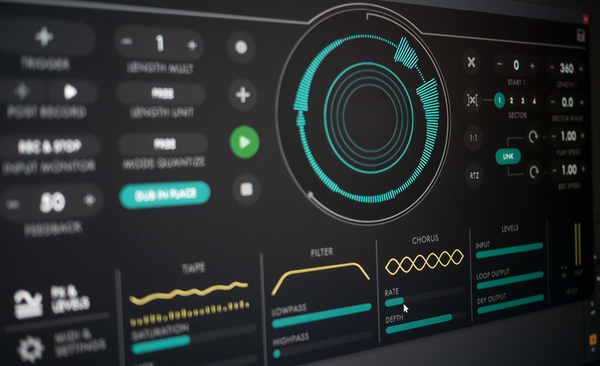
Enso, A Looper...
Posted on
After Quanta's release last summer, Adam and I wanted to tackle something with a somewhat smaller scope. Quanta was a big project for two people to pull off, and we needed a bit of a break from grandiosity. So we decided to do Enso, our looper idea that we had originally designed as a Eurorack module and shown at Machines In Music in 2017. It went like this:
Me: "How hard would it be to do Enso as a plug?"
Adam: "Pretty easy, actually. We've already done the design."
Me: "Okay, let's do that!"
Oh, the blind faith of youthful endeavors! The general idea of looping (fill a buffer with sound, and play it over and over again) is pretty simple. But for a capable looper instrument/effect, there are, as it turns out, approximately 1.5 quadrillion corner cases. It was the opposite of pretty easy.
The main looping engine is fairly similar in operation to Live's Looper plugin; much of our motivation was driven by a desire to use this excellent built-in elsewhere. Ableton did a fantastic job designing it, and our feeling was that it was better to realign that particular wheel than to reinvent it. So far so good. We also wanted to have, in addition to the typical looper "feedback" mode where the input is mixed directly with the buffer contents, something more akin to Frippertronics / tape-looping, where speed changes and effects were "stacked" upon repeated overdubbing, resulting in a degrading loop. This took some pondering, but we got it in there, accessed via the "DUB IN PLACE" button.

The real trouble, and what sets Enso apart from your average looper, started when we acquired a Montreal Assembly Count To Five pedal. This darling of the boutique pedal world takes advantage of a quirk of interpolated delays that is somewhat difficult to work around (and what made Dubstation and Ronin, our original "real" delay products, so difficult). The net result of embracing this quirk rather than dealing with it is that the play head and the record head are decoupled. It takes a minute to get your head around it, but essentially, if you think of Enso's buffer as a tape loop with two decks (imagine a Frippertronics system) and then you picture the direction and speed of the recording deck is different than the one playing back, you quickly start to see the potential for both creative audio exploration and a somewhat nightmarish collection of weird problems.
If you follow me on Instagram, you'll note that I've been using the iOS version of Enso (the iOS and desktop plugins are more or less identical) fairly regularly in my posts; I've also used it in live performance along with real tape loops. It has, during the course of development and testing, essentially become my main musical tool. We've always been somewhat reticent to dip our toe in to the looper community's waters, because the people that use loopers in their creative endeavors tend to hold fairly intense opinions. But with Enso, we're confident that we've made a tool that covers a broad swath of their needs, while also appealing to users that just want a looper plugin that can do that one thing they need to do, in the DAW they need to do it in.
We've worked very hard on this product, and in the immortal and unavoidable words of Tim Cook, we liked it so much we made a video about it.
- Chris Randall
- Phoenix, Arizona
- February, 2019
Since 2002, Audio Damage has been making creative software for discerning musicians.
